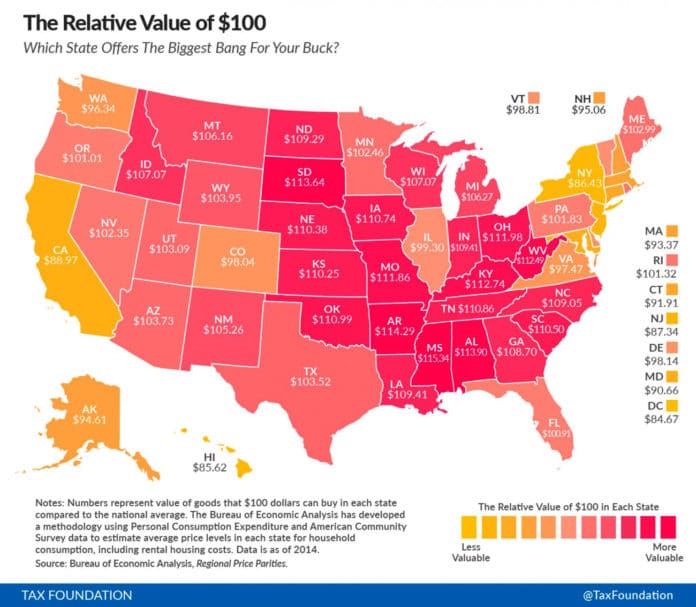You might think you know the value of a buck. But a recent Tax Foundation analysis provides a stark illustration of just how much further a dollar goes in some parts of the country than in others.
It’s no secret that some regions of the country are more expensive than others. This is most obvious when it comes to things such as rent, which is nearly twice as high in New York state as it is in Mississippi. These disparities extend to all sorts of other prices too, for items such as food, gas, and utilities.
The flip side of this, of course, is that income can differ drastically from place to place, as well. The average household income is a lot higher in New York ($54,310) than it is in Mississippi ($35,521), which takes some of the sting out of those higher prices. So to get a true comparison of the value of a buck across state lines, you’d need to crunch the numbers showing how much money people make AND how much things cost where they live.
That’s exactly what the Tax Foundation recently did, using newly released numbers from the Bureau of Economic Analysis. They found that, compared to the national average, $1 in New York state will buy you about 14 cents less. If the average American can buy a chocolate candy bar for a buck, in other words, a New Yorker would only get 86 percent of that candy bar for the same amount of money.
Check out the Tax Foundation’s map. They used $100, rather than $1, as the point of comparison.
Conversely, a buck goes a long way in a place such as Arkansas or Mississippi. Folks there get about 1.15 candy bars for the average national buck. Or in other words, if you take your New York dollar and fly to Mississippi, you can buy a candy bar thatis a whopping 33 percent bigger than what you’re used to.
Or look at it this way: If you lived and worked in New York, and then one day decided to uproot and move to Mississippi, and you kept your same job at your same wage via telecommuting, that would be akin to giving yourself a 33 percent raise. Not bad!
The downside to this plan, of course, is that you’d be living in Mississippi. (I kid).
Given the rise in the availability of telecommuting it may seem surprising that more workers aren’t negotiating telework arrangements that allow them to live in less-expensive areas of the country. But of course there are other factors at play, too. Many people, as it turns out, enjoy living in densely populated areas with lots of food and entertainment options within walking distance. Good luck getting tickets to “Hamilton” if you live 30 miles outside of Biloxi, Miss.
All these differences matter a lot in some of the big public policy debates we’re having on things such as the federal minimum wage and tax policy. As the Tax Foundation analysis shows, a $15 minimum wage would mean a very different thing in Mississippi than it does in New York.






